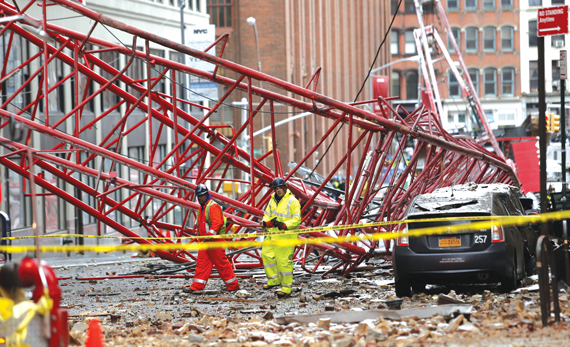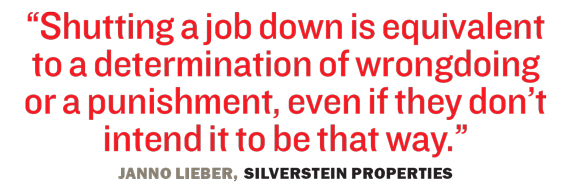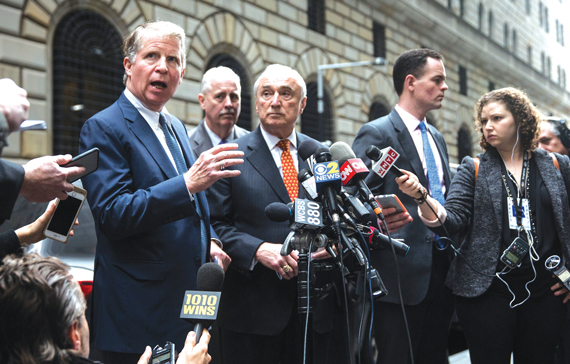Trending
The cost of tragedy
As the number of construction accidents soars, building in NYC is proving riskier than ever

On a blustery morning in February, the members of a crane crew at a Tribeca construction site could feel the enemy at their backs. By around 8 a.m., wind gusts had picked up to 20 miles per hour. Workers decided it would be wise to lower the crane’s boom, whose red steel neck stretched a towering 565 feet above Worth Street. Sitting at the controls was a 56-year-old union crane operator with nearly 20 years of experience. But what was intended as a slow and careful descent suddenly spiraled out of control. The 330-ton crane toppled onto the street, crashing into a parked car. One pedestrian was instantly killed, while three others were injured.
“We lost a life. But if you go out into the street as I did and see what happened here, thank God it was not worse,” Mayor Bill de Blasio said afterwards.
In a city whose skyline might be dotted with more than 400 cranes on any given day, construction safety has always been a particularly fraught issue. With every crane accident come investigations, criticisms and a wave of regulations designed to ensure that the same lapses never reoccur. Yet the fact remains that New York City has seen a disturbing surge in the number of workers hurt or killed on construction sites. According to a report last month from the de Blasio administration, the number of construction-related accidents hit 500 in fiscal year 2016, compared to 314 the previous year — a 59 percent jump and a more than 200 percent increase from 2012. By the city’s count, 11 people died on construction sites in 2015, up from eight the previous year and four in 2011. An investigation by the New York Times found that many of the construction-site deaths and accidents last year were “completely avoidable” and could have been remedied with basic safety measures.
While, undeniably, the greatest cost is to the workers and families impacted by these accidents, the city’s real estate industry has also incurred a lasting impact, from rising insurance premiums to costly litigation to tightening safety regulations that often amount to longer construction times. Developers, contractors and city officials who spoke to The Real Deal said that dealing with the high volume of construction-related accidents is a balancing act of promoting worker safety without unnecessarily hampering progress on construction sites. Right now, they added, the balance is as imperative, but also as imperfect, as ever.
Ripple effect
A major accident on a New York construction site, especially one resulting in a fatality, can rattle the entire industry. Immediately after the Tribeca crane crash, the city ordered operators to secure the 376 crawler cranes and 43 tower cranes, which are stationary and the tallest standing cranes, on construction sites throughout the city. Two days after the incident, de Blasio announced that all crawler cranes would have to stop working when winds higher than 20 mph were forecasted, even if that meant securing the crane the day before. The mayor also more than doubled penalties for failing to safeguard a crane, to $10,000 from $4,800. Some industry trade organizations griped that the changes stalled progress, and criticized what they felt to be a knee-jerk reaction to tragedy.
 Janno Lieber, the World Trade Center project director for Silverstein Properties, said that while investigations are crucial after construction accidents, projects shouldn’t be penalized if no wrongdoing took place. In August, after a crane crashed into a 12th-story window at 3 World Trade Center, construction was shut down for several days. In the end, no violations were issued, Lieber said.
Janno Lieber, the World Trade Center project director for Silverstein Properties, said that while investigations are crucial after construction accidents, projects shouldn’t be penalized if no wrongdoing took place. In August, after a crane crashed into a 12th-story window at 3 World Trade Center, construction was shut down for several days. In the end, no violations were issued, Lieber said.
“I know that they’re doing their best,” he said, “but I hope that the regulatory authorities can bear in mind that because shutting a job down imposes huge costs, it is equivalent to a determination of wrongdoing or a punishment, even if they don’t intend it to be that way.”
Following an extremely high number of construction-related deaths in the city in 2008, the Department of Buildings enacted more than 25 safety-related rules, including requiring national certification for hoist machine operators and encouraging the use of cocoon netting systems, which are designed to catch people and objects along the perimeter of a building.
In the first half of this year, the DOB has issued a record number of stop-work orders. The agency issued 4,580 stop-work orders in the first six months of 2016, Politico reported. That represented a 23 percent jump from the same time the previous year and a 70 percent increase from 2012, when only 2,701 orders were issued.
Yoel Borgenicht, president of King Rose Construction, said he welcomes DOB visits but warned, “Anytime the regulatory environment becomes more complex, it slows things down.”
Safety, he added, “comes with a cost.”
On larger-scale projects, those costs can really add up. For example, the Port Authority of New York and New Jersey paid $9 million to use a cocoon netting system on One World Trade Center.
Lieber said Silverstein generally spends between $5 million and $8 million on safety for its larger projects, like the World Trade Center towers, a price tag that includes the $750,000 the developer spends on an on-site medic.
But from the government’s perspective, the more problematic issue is that the project owners and developers are often absent from the conversation when it comes to assigning blame in the aftermath of a construction-site accident. While an accident can slow down production, hurt a developer’s reputation and rack up costs, the Occupational Safety and Health Administration doesn’t usually have jurisdiction over the developers and owners.
Robert Kulick, OSHA’s regional administrator in New York, said that most of the time, he is dealing with contractors and subcontractors.
“It’s unfortunate [developers] are able to use the law,” he said. “Do we believe that they should be good stewards and hire the right people, who will keep their employees safe? Yes, we do. Unfortunately, there is no legal requirement for them to respond to us.”
Many of the developers and large contractors that TRD reached out to either declined or did not return requests for comment.
Insurance minefield
New York is widely considered one of the costliest places in the United States to write construction risk. By law, most contractors must get project-specific general liability insurance (the exceptions are single- or two-family homes and projects that don’t rise above 35 feet).

Manhattan District Attorney Cyrus Vance Jr., left.
Bill Motherway, president of insurance brokerage Conner Strong & Buckelew’s New York operations, who worked as a risk manager for 20 years at Tishman Construction, said insurance usually costs between 8 and 10 percent of a project’s total cost, but three or four years ago, the range was between 5 and 6 percent. This cost is usually built into the project’s contract and largely falls to the developer/owner. In 2011, the city increased general liability coverage for projects involving tower cranes to $80 million from $10 million, following two fatal crane collapses in 2008.
The sky-high insurance premiums are a product of myriad factors. There are the obvious reasons of density and the concentration of high-rise projects, but the bigger influence on liability is an 1885 state statute known as the “Scaffold Law.” The statute holds contractors and owners liable for all injuries related to elevation. Opponents of the law, which include contractors, property owners and insurers, have argued that it unduly burdens contractors and property owners and hurts the state’s economic development. A 2013 report by the Nelson A. Rockefeller Institute of Government estimated that the labor law cost private businesses involved with non-residential construction $1.5 billion in insurance per year.
Lieber contended that the law hurts all workers. “One person may be winning the lottery in some big settlement. They’ve obviously been injured. I don’t mean to make light of it. But putting these huge costs all on the project is not supporting safety and not supporting responsible development,” he said.
Joe Charczenko, partner at insurance brokerage Construction Risk Partners, blamed New York’s Scaffold Law for skyrocketing insurance costs and noted that the economic downturn of 2008 also led the city’s biggest construction insurers, like AIG, to back away from writing risk.
“If you were to build a $100 million building in Jersey City, you’re going to pay $3 million,” he said. “In New York City, it’s $9 million or $10 million.”
But proponents of the law, like New York Law School’s Center for Justice and Democracy, have said that the legislation is a necessary safeguard for workers in an extremely dangerous industry. Other advocacy and labor groups have contended that the law keeps employers accountable and workers safe, and that there isn’t necessarily a correlation between climbing insurance rates and the Scaffold Law.
Union vs. non-union
In New York City, the rise in construction-related accidents has only intensified the debate and rift between union and non-union construction workers, especially as more developers hire non-union shops to build out their projects. According to OSHA, a majority of New York City’s construction-related deaths — 83 percent — occurred on non-union sites. Union contractors are also quick to point out that a majority of the fatal accidents in New York last year occurred at sites of projects of 10 stories or less, most of which were overseen by non-union contractors. When Carlos Moncayo, a 22-year-old Ecuadoran immigrant living in Queens, was crushed to death in April 2015 at a construction site in the Meatpacking District where developers Aurora Capital Associates and William Gottlieb Real Estate are building a Restoration Hardware store, labor leaders railed against the non-union contractor, Harco Construction.
Gary LaBarbera, president of the Building and Construction Trades Council of Greater New York, said he fears that union contractors who have strong safety records will be negatively impacted because of “irresponsible contractors and developers.”
For their part, non-union contractors argue that the increase in worksite deaths is instead a result of the massive amount of construction going on in the city. The aforementioned NYT report, however, found that the rise in deaths and injuries “far exceeds the rate of new construction over the same period.”
Legal judgments
In June, a judge found Harco guilty of manslaughter for the death of Moncayo. Prosecutors argued that the contractor had knowingly ignored safety concerns. Harco’s lawyer Ron Fischetti criticized the verdict, telling Newsday, “It appears that any tragic accident that happens on a construction site, without any evidence of wrongdoing, the general contractor is liable.”
The Harco case proved to be a watershed moment in construction safety cases: Although the Manhattan district attorney’s office has a long history of prosecuting unsafe contractors and subcontractors, it was the first manslaughter conviction of a construction company in the borough in recent memory.
“We are very selective, and appropriately selective, about what cases are taken criminally,” Manhattan District Attorney Cyrus Vance Jr. recently told TRD. “We think that’s the appropriate use of our judgment as prosecutors to make sure we are distinguishing the accident from the fatal injury that occurred as a result of knowingly disregarding risk.”
Still, some argued that the penalties Harco faced weren’t strict enough. A judge ordered the company to create a public-service announcement about worksite safety or else face a $10,000 fine. At the time, Dennis Lee, a representative of the Laborers’ International Union, referred to the $10,000 penalty as “chump change.”
But it’s clear that amid mounting accidents, construction safety is garnering more attention from elected officials. In August 2015, shortly after the Harco construction worker’s death, Vance launched a construction fraud task force. Since that time, the group has met with more than 800 construction workers to discuss their rights and address their concerns.
“We are not fighting against the construction industry,” Vance said. “I truly believe that the overwhelming majority of contractors and builders in New York want the same things we do, which is to have safe construction sites, that build first-rate buildings and that we all benefit from, but not at the expense of, worker safety.”
Several months after the Tribeca crane collapse, the city eventually walked back from some of its initial reforms, in part because of pressure from the Real Estate Board of New York. The DOB in July adopted changes to how cranes operate in the city, which included restricting crawler crane use when winds exceed 30 mph — based on on-site measurements, rather than a blanket ban for the city. The recommendations, which emerged from a working group organized by the mayor, also continued a ban on the kind of crane that was involved in the crash, i.e., one that can’t be used when winds exceed 20 mph. The DOB now also requires that construction sites have a “lift director” to monitor weather and oversee the response.
But ultimately, while larger contractors have internalized the importance of safety on their sites, smaller contractors have some way to go, according to Richard Lambeck, president of RL Project Management and a professor at New York University’s Schack Institute of Real Estate.
“There’s so many ramifications of accidents on a construction site. The insurance rates go up, productivity goes down, the DOB has more inspectors out,” he said. “In our business, time is money. And an accident costs a lot of money.”




